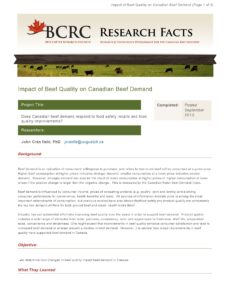Does Canadian Beef Demand Respond to Quality Improvements?
Beef demand is an indication of consumers’ willingness to purchase, and refers to how much beef will be consumed at a given price. Higher beef consumption at higher prices indicates stronger demand; smaller consumption at a lower price indicates weaker demand. However, stronger demand can also be the result of lower consumption at higher prices or higher consumption at lower prices if the positive change is larger than the negative change. This is measured by the Canadian Retail Beef Demand Index.
Beef demand is influenced by consumer income, prices of competing proteins (e.g. poultry, pork and lentils) and evolving consumer preferences for convenience, health benefits and taste. All sources of information indicate price is among the most important determinants of consumption, but previous studies have also shown that food safety and product quality are consistently the top two demand shifters for both ground beef and steak.
A recent study led by Dr. John Cranfield at the University of Guelph examined how changes in beef quality impact its demand in Canada. Among the lessons learned were the challenges of measuring and interpreting beef quality, trade-offs between quantity and quality, and relationships between beef and competing meats.
The study found that increasing overall beef demand requires increasing the total value of cuts from the entire carcass. Predictable, consistent eating quality in middle meats (loin and ribeye) are very important, but beef quality research that leads to increased consumer satisfaction with and consumption of end cuts (rounds and chucks) is equally important. Opportunities may exist to develop thin meats (e.g. cuts from the diaphragm and flank) into new products that are consistent, convenient, enjoyable and appealing to Canadian consumers. Increasing beef quality can have unintended consequences, particularly if it results in consumers focusing on a limited number of cuts from a small portion of the carcass and avoiding the rest. Products that consistently fail to meet consumers’ quality expectations have a significant negative impact on beef demand.
To learn more about this study of the impact of quality improvements on beef demand, see the BCRC fact sheet.
Stay tuned for a summary of the impact of food safety recalls on beef demand in Canada.
Click here to subscribe to the BCRC Blog and receive email notifications when new content is posted.
The sharing or reprinting of this BCRC Blog article is welcome and encouraged. Please provide acknowledgement to the Beef Cattle Research Council, list the website address, www.BeefResearch.ca, and let us know you chose to share the article by emailing us at [email protected].
We welcome your questions, comments and suggestions. Contact us directly or generate public discussion by posting your thoughts below.
